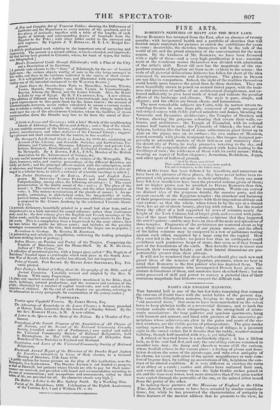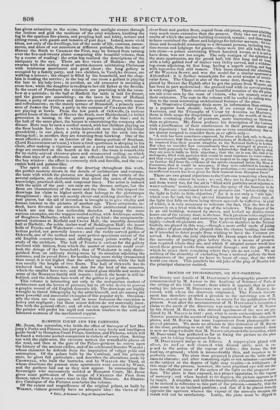NASH'S OLD ENGLISH i1 .INSiONS.
THE baronial ball is one of the last few links remaining that connect the customs of feudal times with the social habits of the present day. The venerable Elizabethan mansion, keeping its state amid groves of "old ancestral trees," that seem to have been marshalled on the velvet lawn to keep plebeian traffic at a reverential distance, and to hush the verdant solitude with their whisperings, is the strong-hold of aristo- cratic associations: the long galleries and spacious apartments, hung with banners and armour, and lined with pictures of the successive ge- nerations whose achievements glow in the• guiles and azure of' the sto- ried windows, are the visible poetry of primogeniture. The gray smoke curling upward from the green bosky clumps of foliage, is a pleasant sight to the casual visitor, for it denotes that the ruddy, weather-stained building, though half-mum led with ivy, is yet inhabited. A mined or deserted house is a melancholy object ; it has a lifeless look, as if the soul had fled, and only the crumbling carcass remained to moulder into dust : the damp and cheerless rooms chill the curious, whose fiiotfall echoes in the vacant place a feeling of gloom mid deso- lation deadens the sense of the picturesque, and robs even antiquity of its charm, for every indication of the quaint magnificence or rude corn- fort of bygone days, by calling up associations of life, heightens the con- trast of its altered condition. It is very different in viewing the ruins of an abbey or a castle ; castles and abides have outlasted their uses, and weeds and decay become them : the light Gothic arches poised in air, and the time-rent tower, look inure attractive than if t be grim warder were espied through the portcullis of the one, or the mitred abbot issued from the portal of the other. In making these pictures of the Mansions of England in the Olden Time, JOSEPH NA su seems to have been actuated by similar considera- tions; for, while he has preserved the characteristics of antiquity in those features of the ancient edifices that he presents to the view, he has given animation to the scene, letting the sunlight stream through the lattices and gild the mullions of the oriel windows, kindling the log in the spacious fire-places, and peopling hall and lobby, terrace and sitting-room, with guests and inmates of past days. Indeed, more vivid ideas, not only of the dwellings, but of the mode of life, customs, amuse- ments, and dress of our ancestors at different periods, from the time of HENRY the Sixth to CHARLES the First, may be formed from turning over the five-and-twenty plates composing this beautiful volume, than by a course of reading : the artist has realized the descriptions of the antiquary to the eye. There are five views of Haddon : the hall swarms with the motley rout of morris-dancers celebrating Christmas with boisterous merriment and good cheer ; the long gallery is occupied by a family party, and two children, in Vandyke dresses, arc walking a minuet ; the chapel is filled by the household, and the chap- lain is reading the service ; in the bay of one room a gallant is playing the lute to his lady-love ; in another, an old armourer is mending a cross-bow, while the daughter is reading to her old father at the fireside. In the court of Penshurst the retainers are practising with the cross- bow at a quintain ; in the hall at Hatfield the table is laid for dinner, and the guests are assembling ; on the lawn in front of Holland House, a party of cavaliers and dames are seated alfresco, with music and refreshments ; on the stately terrace of Brainshill, a princely man- sion of JAMES the First, a party in the costume of CHARLES the First are playing at bowls. From the low porch of Ockwells, (a curious gabled house of the date of Hissay the Sixth, near Maidenhead,) a bridal procession is issuing, in the quaint pageantry of the time ; and in the hall of the same place, the harper is entertaining the company after dinner. Here may be seen a mother seated, with her children playing on the floor beside her ; there a white-haired old man leading his infant grandchild ; in one place, a party is preceded by the cook into the dining-hall ; in another, they are returning from hawking. One of the most effective plates is an interior. of the dining-parlour of Southam, (Lord ELLENBOROCGII'Sseat,) where a tired sportsman is sleeping in his chair, after making a vigorous assault on a pasty and tankard, and his dogs are stretched on the hearth at his feet : the room is remarkable for its richly-carved chimney-piece and ornamented ceiling, on which the slant rays of an afternoon sun are reflected through the lattice of the bay window : the effect is extremely rich and forcible, and the exe- cution bold and painter-like.
The spirit and freedom of the drawing throughout this work, the perfect mastery shown in the details of architecture and costume, the taste with which the pictures are designed, and the variety of the several subjects, are characteristics that attest the union of thorough knowledge, practised skill, and congenial fancy. The artist is imbued with the spirit of the past : not only are the dresses antique, but the faces are characteristic of the scene and the time. In this respect the drawings lay claim to higher merit than belongs to the picturesque draughtsman : they are not merely clever and striking sketches of ac- tual places, but the aid of invention is brought in to give vitality and human interest to the pictures of another age. These attractions, in- deed, have diverted our attention from their architectural features ; which are not the less noticeable therefor. Among the more curious examples, are the waggon-roofed ceiling, with Arabesque scrolls, of Boughton-Malherbe, which is unique of its kind ; the sumptuously- carved staircases at Hatfield and Crewe Hall; the superbly decorated ball at Hatfield ; the noble timber-roof of Beddiugton Hall; the lesser halls of Franks and Wakehurst—two small manor-houses of the Eliza- bethan period, not generally known ; and the richly-carved gables of Ockwells, one of the earliest and most perfect specimens extant of the old English country-house,. and offering many points worthy of the study of the architect. The hall of Franks is curious for the gallery enclosed with lattices, from which the master or mistress could over- look the doings of the household ; that of Wakehiurst is only distin- guished from an ordinary dining-room by its situation adjoining the entrance, and its paved floor ; for besides being more richly ornamented than usual, it is not higher than the other apartments, while the hall was usually the height of two floors. The hull of Ockwells has its
timbered roof, bay window, and dais for the lord of the mansion, which the smaller have not; and the stained glass shields and motto of arms of the NORREYS Ibmily still remain : indeed, the house is still in- habited, and the delicate lace-work of the gables is yet perfect.
This volume is interesting not only to the antiquarian student of architecture and the lovers of pictures, but to all who desire to possess
a graphic record of old English domestic life. The drawings are highly
wrought in tinted lithography by the artist himself, and arc among the most powerful and successful examples of this popular style. Occasion- ally the tints are too opaque, and in sonic instances the execution is heavy and negligent ; but these minor defects do not materially inter- fere with the general effect ; and all who can appreciate the feeling of the painter will prefer his rapid and careless touches to the cold and laboured neatness of the mechanical copyist.



























 Previous page
Previous page